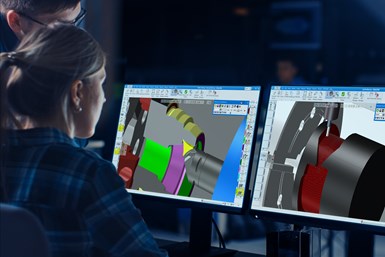GibbsCAM Update Integrates Turning Enhancements From Sandvik Coromant
GibbsCAM 2023 integrates Sandvik Coromant’s PrimeTurning, which uses the slope of the insert for chip thinning to make heavy cuts and spread cutting forces and heat over a larger portion of the cutting edge.
Share





Cambrio announces the release of GibbsCAM 2023. New developments continue the focus on core capability, while introducing new technology in collaboration with Sandvik Coromant.
GibbsCAM 2023 features a number of turning enhancements, including the implementation of Sandvik Coromant’s PrimeTurning strategies. These new cutting methodologies permit turning and facing in all directions, which the company says delivers dramatic increases in high volume production.
PrimeTurning can reportedly deliver cycle time reductions of up to 50% and more than 500% increase for insert tool life. PrimeTurning uses the slope of the insert for chip thinning to make heavy cuts and spread cutting forces and heat over a larger portion of the cutting edge, contributing to longer tool life. In addition, PrimeTurning adapts the feedrate to constantly manage chip thickness, which is ideal for high-volume and unattended environments. PrimeTurning supports two new tool types: CoroTurn Prime Type-A with three 35° corners for finishing and fine roughing and CoroTurn Prime Type-B with two strong corners for bulk roughing and heavy cutting. Both tool types utilize a low lead angle to improve surface finish.
Other enhancements include a new option in most turning processes to control cutting load variation in order to suppress resonance-induced chatter and improve chip breaking for CNC machines. This machine capability is also called variable spindle speed by Okuma, and low frequency vibration by Citizen. VoluTurn functionality has also been extended to manage the active control of chip thickness during the cut by varying the feed rate instantaneously with any changes in cut depth.
Thread turning operations have been expanded with face threading, variable pitch threading, multi-pitch and position tool front options. Users can produce a spiral thread on the face of a part, vary pitch threads incrementally per revolution or generate different pitches on a continuous thread, with easy control of exact start/end specs in the tool dialog.
Alongside other turning enhancements, it is now possible to specify rake and back relief for tool inserts to more accurately define the 3D geometry of the tool inserts to provide a tool representation that perfectly matches what the customer is experiencing. Also, the elliptical contour process can now be used for elliptical bores inside of solid parts, and supports a radial (Xr) stock offset for both inner diameter (ID) and outer diameter (OD) machining.
GibbsCAM 2023 extends the default drill cycle types to include five more: gun drilling, variable peck (full out and chip breaker) and peck tap (full out and chip breaker). In addition, a new multifunction insert drill type is supported, which can be used to perform both turning and drilling/boring operations. The multifunction insert drill tool type can seamlessly switch between turning, lathe drilling and mill drilling without retraction or tool change motions. Also included is a new option for lathe drilling with counter-rotating tools that instructs the live tooling spindle to turn in the opposite direction at a specified RPM to increase spindle speed and boost material removal rates.
Related Content
-
6 Machine Shop Essentials to Stay Competitive
If you want to streamline production and be competitive in the industry, you will need far more than a standard three-axis CNC mill or two-axis CNC lathe and a few measuring tools.
-
4 Commonly Misapplied CNC Features
Misapplication of these important CNC features will result in wasted time, wasted or duplicated effort and/or wasted material.
-
ERP Provides Smooth Pathway to Data Security
With the CMMC data security standards looming, machine shops serving the defense industry can turn to ERP to keep business moving.

























